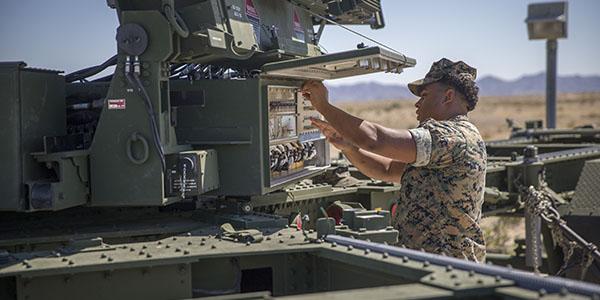Defense Experts Plan More Agile Spectrum Use
The Defense Information Systems Agency (DISA) is leading three different efforts that are working toward agile electromagnetic spectrum operations. While one focuses largely on improved spectrum usage by the military, the main focal point is to share bandwidth with civilian users in a way that does not inhibit either military operations or public bandwidth uses.
These three efforts were discussed by experts at TechNet Cyber 2020, AFCEA’s virtual event being held December 1-3. Leading officials with DISA and industry are outlining challenges and opportunities beckoning the defense communications community.
The first agile spectrum effort is Electromagnetic Battle Management (EMBM), a new program due to start this fiscal year. It focuses on operational command and control (C2) of the electromagnetic spectrum for combatant commanders. Alan Rosner, Joint Spectrum Center, DISA Defense Spectrum Organization, describes this as a capability focusing on joint task forces that have operational spectrum support cells. It provides superiority within the electromagnetic environment, Rosner said.
We have to use the electromagnetic operational environment much more carefully and smarter than we do today.—Alan Rosner, Joint Spectrum Center, DISA Defense Spectrum Organization #AFCEACyber #AFCEA @USDISA
— Bob Ackerman (@rkackerman) December 1, 2020
He continued that it entails providing vital information to the commander in a joint task force so that commander can make a decision affecting the electromagnetic environment. It also would improve overall situational awareness of that environment. Above all resides C2 of those activities.
The agency is working with partners to develop an overarching electromagnetic spectrum enterprise architecture, or ESEA. Other activities involve Army and Marine Corps operations and interfaces. The program will be operated under the new adaptive acquisition framework, and its RFI was issued in November. The RFP could occur during the winter.
The second is the Spectrum Management Coordination System (SMCS), which shares with broadcast electronic news gathering inside the United States. Ed Coyle, engineer, Strategic Planning Division, DISA Defense Spectrum Organization, explained that it is part of the Advanced Wireless Services 3 (AWS3) program. The AWS came about as part of spectrum auctions to commercial firms in 2015 that encompassed some Defense Department bands.
He explained that the SMCS will enable scheduling and sharing between the Defense Department and the broadcast auxiliary spectrum (BAS). The two primary types of sharing will be pre-coordinated access and active coordinated access. Pre-coordinated access will involve channels that have been analyzed by the Defense Department and the BAS and found to be available for use. Approval take place with as little as 24 hours’ notice. Active coordinated access is more complex and requires more analysis for effective coordination, he noted.
Beginning with manual sharing via email, the SMCS will incorporate a coordination portal with analytic tools in its base year. After five years, it will become completely automated with machine-to-machine information exchange. The defense systems entering this band sharing will include tactical relay radio, small unmanned aircraft systems and tactical targeting network technology. Broadcasters will offer fixed links among news outlets and mobile/portable links for news gathering, Coyle offered.
The third is Telecommunications Advanced Research and Dynamic Spectrum Sharing Systems (TARDyS3), which shares spectrum use with Citizens Broadband Radio Service (CBRS) in the United States. Kasey Pugh, an engineer in the Strategic Planning Division, DISA Defense Spectrum Organization, is the lead engineer for TARDyS3. He explained that the program has been working across the Defense Department since 2012 as well as with other government organizations to come up with a solution to shared spectrum access between defense radars and commercial mobile broadband.
The Defense Department’s existing capabilities to effectively manage interference to and from its radars would be incompatible with the as-implemented commercial ecosystem.—Kasey Pugh, engineer, strategic planning division, DISA Defense Spectrum Organization #AFCEACyber @USDISA
— Bob Ackerman (@rkackerman) December 1, 2020
Pugh offered that this program’s approach to coordinating spectrum sharing with radio services will be the same as it does internally. Three initiatives will help determine TARDyS3 activities. A Defense Department spectrum sharing team will lead government activities in the 3550-3650 megahertz band. A CBRS sharing ecosystem assessment will aim to prove the viability of permanent sharing between the Defense Department and the CBRS. And, a TARDyS3 tool suite will help implement activities.
One lesson learned from this effort, Pugh related, is that the Defense Department’s internal spectrum deconfliction efforts will not work with commercial bandwidth users. “The Defense Department’s existing capabilities to effectively manage interference to and from its radars would be incompatible with the as-implemented commercial ecosystem,” he said.
To resolve that, the Defense Spectrum Organization will develop an interference prevention, detection and resolution (IPDR) capability and a spectrum scheduling system as part of the tool suite. This will ensure that defense radar operators are able to effectively plan and conduct spectrum operations alongside Citizens Broadband Radio Service. The Defense Department also will be able to maintain full operational capability while simultaneously enabling widespread commercialization of this bandwidth across the United States, Pugh said.
He added that several innovative solutions will help realize these goals. They include cloud-native bi-directional cross-domain solutions across the Internet, spectrum scheduling business process automation, electromagnetic interference prediction functionality and asynchronous operations such as supporting end users with degraded, intermittent, limited network connectivity.





Comments